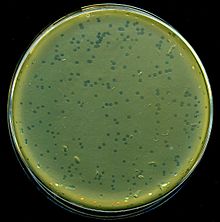Enterobacteria phage lambda
| Enterobacteria phage λ | |
|---|---|
 |
|
| Lysis plaques of lambda phage on E. coli bacteria | |
| Virus classification | |
| Group: | Group I (dsDNA) |
| Order: | Caudovirales |
| Family: | Siphoviridae |
| Genus: | λ-like viruses |
| Species: | λ phage |
Enterobacteria phage λ (lambda phage, coliphage λ) is a bacterial virus, or bacteriophage, that infects the bacterial species Escherichia coli (E. coli). It was discovered by Esther Lederberg in 1950 when she noticed that streaks of mixtures of two E. coli strains, one of which treated with ultraviolet light, was "nibbled and plaqued". This virus has a temperate lifecycle that allows it to either reside within the genome of its host through lysogeny or enter into a lytic phase (during which it kills and lyses the cell to produce offspring).
The phage particle consists of a head (also known as a capsid), a tail, and tail fibers (see image of virus below). The head contains the phage's double-strand linear DNA genome. During infection, the phage particle recognizes and binds to its host, E. coli, causing DNA in the head of the phage to be ejected through the tail into the cytoplasm of the bacterial cell. Usually, a "lytic cycle" ensues, where the lambda DNA is replicated and new phage particles are produced within the cell. This is followed by cell lysis, releasing the cell contents, including virions that have been assembled, into the environment. However, under certain conditions, the phage DNA may integrate itself into the host cell chromosome in the lysogenic pathway. In this state, the λ DNA is called a prophage and stays resident within the host's genome without apparent harm to the host. The host is termed a lysogen when a prophage is present. This prophage may enter the lytic cycle when the lysogen enters a stressed condition.
The virus particle consists of a head and a tail that can have tail fibers. The whole particle consists of 12–14 different proteins with more than 1000 protein molecules total and one DNA molecule located in the phage head. However, it is still not entirely clear whether the L and M proteins are part of the virion.
...
Wikipedia
